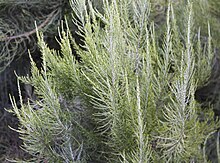Dicerothamnus rhinocerotis
| Dicerothamnus rhinocerotis | |
|---|---|

| |
| Scientific classification | |
| Kingdom: | Plantae |
| Clade: | Tracheophytes |
| Clade: | Angiosperms |
| Clade: | Eudicots |
| Clade: | Asterids |
| Order: | Asterales |
| Family: | Asteraceae |
| Genus: | Dicerothamnus |
| Species: | D. rhinocerotis |
| Binomial name | |
| Dicerothamnus rhinocerotis (L.f.) Koek.[1] | |
| Synonyms[1] | |
| |
Dicerothamnus rhinocerotis, synonym Elytropappus rhinocerotis, (commonly known as renosterbos or "rhinoceros bush") is a species of flowering plants in the daisy family, Asteraceae, endemic to South Africa. It is a very obvious component of the unique Renosterveld Vegetation Type, which is named after this bush.
Distribution
Although the Renosterveld Vegetation Type is confined to the South-Western Cape of South Africa, the Renosterbos plant is much more widespread - occurring throughout the Cape Floristic Region and further, as far east as Molteno in the Eastern Cape, and as far north as Namibia. Renosterbos is also relatively common in this area, unlike most plants associated with Renosterveld vegetation.
As a consequence of livestock finding the plant relatively inedible, Dicerothamnus rhinocerotis has spread in heavily grazed areas and increased in numbers relative to other (more easily grazed) plants.
Uses
Dicerothamnus rhinocerotis is a medicinal plant in traditional African medicine. The young tips of the branches are used in traditional medicine to treat indigestion and stomach ulcers.[citation needed] The foliage tips are now usually added to wine or brandy for such medicinal consumption.[2]

Cultivation
Dicerothamnus rhinocerotis is cultivated as an ornamental plant for South African native plant, drought tolerant, and wildlife gardens. It is also planted in natural landscaping and habitat restoration projects.
A cultivar, which has a strikingly crisp, pure-white colour, is usually grown in gardens more than the direct species.
References
- ^ a b "Dicerothamnus rhinocerotis (L.f.) Koek." Plants of the World Online. Royal Botanic Gardens, Kew. Retrieved 2024-05-04.
- ^ "Dicerothamnus rhinocerotis (L.f.) Koekemoer". PlantZAfrica. South Africa National Biodiversity Institute. Retrieved 2024-05-04.
External links
 Media related to Dicerothamnus rhinocerotis at Wikimedia Commons
Media related to Dicerothamnus rhinocerotis at Wikimedia Commons
